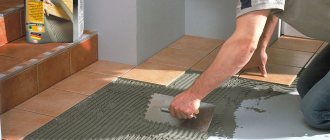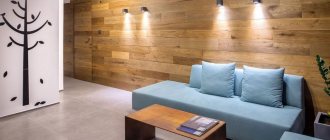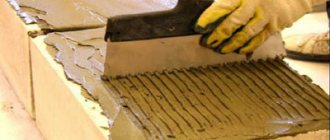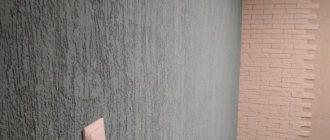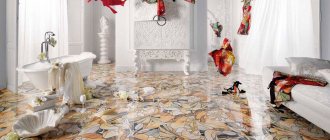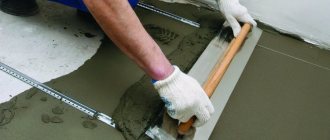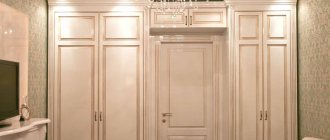Mosaic tiles allow you to decorate the interior and exterior walls of your home in an original way. Small decorative details that create a pattern are attached to the base using adhesives. The quality of the work and the durability of the result depend on whether the adhesive for the mosaic is chosen correctly. Let's look at what to look for when buying a mixture.
Which glue is better to choose
The construction market offers a wide range of adhesive compositions. A person who decides to lay a mosaic canvas on his own cannot always decide which adhesive is best for gluing the tiles. Before buying a product, you need to familiarize yourself with the types of formulations and their main characteristics.
Cement glue
Dry mixtures that are diluted with a solvent to a semi-liquid consistency before laying the tiles. Recommended products:
- KNAUF FLIESEN. Knauf is economical, has high astringent qualities, and provides adhesion when applied in a layer of 0.7 cm. It dries slowly. Suitable for bases with complex configurations.
- Yunis 2000. Fast-drying, highly elastic cement mixture with good adhesion. Hardens in 3 hours.
- Founder of T-12 mastplix. An excellent option for uneven substrates: it evens out even large differences in the surface. Firmly connects the mosaic to the wall or floor.
- CERESIT SM-11. Versatile, sets quickly. Designed for interior decoration. Easy to use.
- Litoflex (Litokol Litoflex) K81. Elastic, durable.
Cement adhesives are universal and inexpensive.
But there is a small drawback: mixing the solution with a construction mixer is accompanied by the appearance of dust. Ready-made adhesive for mosaic tiles on an acrylic base with the addition of additives and resins. Use immediately after opening the package. The main advantage of dispersion solutions is that they do not lose their properties during long-term storage in tightly closed containers.
Dispersion mixtures are elastic and resistant to vibration. The following are in demand among craftsmen:
- Litoacryl Fix, used for gluing mosaics in living rooms. To decorate bathrooms or kitchens, use Litoacryl Plus, which has increased moisture resistance.
- Ultramastic III Mapei from the line of acrylic mixtures from the Italian company Mapei. Suitable for tiling heated floors and walls with mosaic decor in damp rooms.
- Lacrysil glue “Crazy Velcro”. Durable, with zero slippage of elements. After drying, the seams do not soften under the influence of moisture.
Dispersion compositions are more convenient to use, but they are more expensive than cement ones.
Two-component adhesive
Reactive (two-component) composition consisting of a base and a hardener. Popular brands:
- Litokol LitoElastic. Waterproof, can be used on any surface. Finished seams are elastic and not subject to cracking.
- Reactive mixtures from the manufacturer Mapei allow you to glue mosaics even on substrates with low adhesion. The most popular is Keralastic.
- Ceresit CU-22. Strong reactive mixture. Resistant to chemicals, humidity and temperature changes.
Two-component mixtures harden quickly, so you need to try to lay the mosaic elements without mistakes. If you have little experience in gluing decor, then it is better to choose slow-hardening products for laying mosaics.
The disadvantage of two-component mixtures is their high cost. It is not profitable to use reactive adhesives for covering large areas.
Which type of mixture will be the best depends on the type of mosaic, surface characteristics and some other factors.
Tools and materials
To work with mosaics, you should measure the walls or floor, purchase the required amount of base material - small ceramic, plastic or other types of tiles. You also need to buy tile adhesive. There are various types of adhesive base on sale on which the mosaic will adhere perfectly. Here is a list of other materials and tools required for installation:
- grout for mosaic tile joints;
- crosses for forming joints;
- spatula with teeth;
- rubber spatula;
- gloves;
- sponge;
- bucket;
- construction mixer (if the glue is dry).
In the case where a self-adhesive mosaic is purchased, no adhesive is needed. Typically, this material is recommended to be glued to the wall in the kitchen, but in the bathroom, with constant contact with water, it does not last long.
What to consider when choosing a glue
To avoid unnecessary costs and select the right composition, you will need to take into account the specifics of the job, the type of room and the characteristics of the substrates being glued. The glue is selected taking into account the assigned tasks.
Type of mosaic
When analyzing the type of mosaic elements, you need to take into account not only the nature of the material, but also the appearance of the decor. An incorrectly selected composition can ruin the final result.
Glass and mirror
Decorative parts are transparent, so white mosaic glue is required. If you choose a cement mixture, you can take:
- Litoplus K55;
- H40 Tenaflex Eco;
- Flexbond Bianco.
If there are no special requirements, then beginners are recommended to use Axton mosaic adhesive based on white cement.
Dispersion solutions are suitable for laying mirror mosaics in the bathroom or kitchen:
- Drauf + Sitzt;
- Litoacryl.
The addition of latex plasticizers to cement mixtures improves water resistance well:
- Latex kol-m;
- Isolastic.
Additives are mixed with water, and then cement powder is mixed into the resulting solution.
Glue for glass mosaics on a mesh is selected as for glass tiles. There is a slight difference in how to glue the glass mosaic on the mesh.
Made from natural stone
What to put the decor on depends on the characteristics of the stone. There are varieties of marble that change color depending on humidity. For these breeds, waterless two-component adhesives are suitable:
- Litostone K98 and K99;
- Marmor + Granite Kleber.
If the stone parts are immune to moisture, then any composition will do.
Made of plastic
Polyvinyl chloride (PVC) is moisture resistant and can withstand temperature changes well. The plastic parts are lightweight and rarely move. For gluing mosaics you can use:
- liquid Nails;
- cement mixtures;
- dispersion solutions;
- hot melt adhesive.
The choice of product is influenced by the type of room: plastic mosaics for the bathroom or kitchen are glued with waterproof elastic adhesives, but for living rooms you can use any kind.
On the grid
This option is represented by a composition of small decorative components mounted on a soft mesh lattice. The adhesive for mosaic tiles on a grid is selected taking into account the type of decor.
Recommended adhesive for tiles and mosaics:
- Eunice;
- Bergauf;
- Ceresite;
- Litokol.
Choose only a white product for laying mosaics on a glass or mirror mesh. Gray mesh mosaic adhesive will change the color of the pieces and the result will be unsatisfactory.
Paper based
The mosaic details are placed on paper. Epoxy grout is suitable for gluing:
- Litochrome Starlike;
- Kerapoxy Design;
- R2T.
The advantage of using grout is that when gluing, the seams between the elements are partially filled. This speeds up finishing.
3D
The three-dimensional effect for a mosaic panel is achieved using small parts of different heights placed on a paper or mesh base. When choosing which glue to use, you need to take into account the characteristics of the material from which the decor is made:
- Transparent. To avoid damaging the appearance of the mosaic pattern after gluing, you should not use gray adhesives. It is worth choosing white glue Litokol or white Ceresit.
- Stone. It is better to take compounds for stone tiles.
It is necessary to take into account the characteristics of the base. The glue should firmly adhere the decor to the wall.
Other types
The adhesive should be taken taking into account the material of the decorative parts:
- Wooden. Suitable LITOPLUS K55, IVSIL Mosaic.
- Ceramics. It is worth taking Litoflex K80 Eco, Superflex K77, Adesilex P
For gluing opaque decor, the color of the glue is unimportant.
Surface type
You should additionally take into account the characteristics of the surface where the mosaic is glued. An incorrectly selected product will not provide the necessary adhesion, and the decor may fall off.
On tiles
Mosaic patterns can be glued to an already tiled wall. But the resulting surface is smooth and has low adhesion. For gluing to tiles use:
- reactive compounds;
- liquid Nails;
- dispersion agents.
Before gluing, the top layer is scraped off the tile, then priming is carried out to increase the adhesion of the surfaces.
On concrete or plaster
The best option for inexpensive decoration would be cement mixtures:
- Eunice;
- Knauf;
- Ceresite.
For heavy parts, it is recommended to use two-component compounds.
On plastered surfaces
The mosaic can be glued to the putty using any glue selected taking into account the nature of the decorative finish.
Before gluing the mosaic canvas, you need to check whether the plaster is firmly in place. If the plastered layer moves away from the wall, then the elements will not hold firmly. You can glue using popular brands:
- Unis;
- Litokol K55;
- Mosaik.
The adhesive composition should have a medium viscosity: when using liquid products, the tile will slide, and thick ones will make it difficult to distribute the mass evenly.
On a tree
For wooden mosaics, a product designed for gluing wood is suitable. Decorating wooden walls with other materials requires preliminary preparation:
- laying waterproofing;
- installation of construction mesh;
- plastering.
After the wet plaster has dried, you can use any glue for plastered surfaces.
On drywall
Any highly adhesive building mixtures (KNAUF FLIESEN, Litokol) are suitable. Before gluing the mosaic tiles, the drywall is primed to increase the adhesion of the base to the glue.
The plasterboard surface is always smooth and does not deform the mosaic canvas, causing a color change due to the repetition of the bends of the base, so any types of mosaics can be glued to the slabs. You just need to remember that drywall is flexible, and laying a large number of heavy elements can lead to deformation.
Other surfaces
Mosaic decor is glued to all types of bases, selecting the appropriate adhesive:
- Brick. Stiff adhesives will be required to provide maximum adhesion. Founding Mastplix T-12 or Unis will do.
- Chipboard and plywood. Mixtures are selected in the same way as when decorating wooden bases.
- Mirror. For a smooth mirror surface, liquid nails and two-component compounds are used.
When choosing glue, they simultaneously take into account the characteristics of the material of the mosaic elements and what the base is made of. The product should glue materials of different structures together, forming a strong seam after hardening.
Character of the room
It is important to pay attention to where the installation is carried out. A mistake when choosing adhesives will cause the frozen seams to crack and the tiles to fall off.
Pool
The decor will be in constant contact with water, so the adhesive for mosaic tiles in the pool must be moisture resistant. Recommended brands:
- Ultramastic III Mapei;
- Keralastic.
If the pool is lined with transparent decor, then white mixtures are selected for laying the mosaic in the pool.
Bathroom
To glue the decor you need a moisture-resistant composition:
- Drauf + Sitzt;
- Ceresit CU-22.
When the decor is transparent, you should take white tile adhesive Ceresit SM 115. This mosaic adhesive is white, so it will retain the color of the pattern.
Kitchen
The requirements for the tile mixture for the kitchen are the same as for the bathroom: after drying, the adhesive joints should not be deformed due to humidity. Keralastic, liquid nails, and moisture-resistant products with cement are suitable for gluing.
Balcony
The panel pasted on the balcony is exposed to temperature changes. To avoid drying out of the seams, you should take KNAUF FLIESEN or Litokol LitoElastic.
Other premises
When choosing what to use for gluing mosaic decor in rooms, you need to look at the composition of the product - the glue should not contain substances harmful to health. It is worth giving preference to cement and dispersion mixtures.
When decorating non-residential premises there are no restrictions on choice. You can take any composition: after polymerization, toxic additives gradually erode.
Where are mosaics used in the bathroom?
According to the requirements of the standards SP 29.13330 and 109.13330, the floor covering of the bathroom must be lower than the level of the finished floor in the adjacent room, and made together with wall cladding made of waterproof material. Mosaic is a flexible type of tile due to numerous seams between small-format decorative elements.
According to the operational and design features of the finishing material, mosaic in the bathroom is used for finishing the following structures:
- “wet areas” – walls adjacent to plumbing fixtures;
Mosaic tiling of wet areas. - vertical enclosing structures - walls, partitions, boxes along the entire height;
Wall mosaic inside the bathroom. - floors – covering the screed, laying on top of a warm floor;
- elements of plumbing fixtures - lining of the drain, walls of the shower stall, sides of the bathtub, "moidodyr";
Mosaic tiling of the shower stall. - architectural elements - arches, ramps, columns, niches, podiums.
Finishing columns and radius walls with mosaics.
For example, it is almost impossible to tile a radius wall or shower tray with standard sized tiles. And when using mosaics with your own hands, finishing curved surfaces does not cause difficulties, even if the home craftsman is insufficiently qualified.
How to use it correctly
Before starting work, cement mixtures must be mixed with a solvent, and in reactive compositions, the base and hardener must be combined. Dispersive ones do not need to be stirred.
The rules of use are the same for almost all adhesives:
- Mix small portions - this is what the masters recommend. Reactive and cement mixtures quickly thicken and become difficult to work with. The density prevents the mass from being evenly distributed, so the decorative elements are laid unevenly.
- Apply the glue to a small area of the wall in a thin layer. After gluing the decorative elements, the adhesive mixture is applied further. Coating large surfaces causes the adhesive to begin to polymerize before the tile is attached. This reduces the quality of adhesion.
- Most cement mixtures are produced in packages of 25 and 5 kg. If you plan to decorate large areas, it is cheaper to buy in large packs.
Color
The mosaic should match the color style of the rest of the kitchen. The apron can be decorated in a single color or create a gradient, as in the photo.
Either with ornaments, drawings or patterns.
Another stylish move is to use grout that contrasts with the mosaic tiles. For example:
- for white mosaic, black or gray grout;
- for beige - beige-brown epoxy - so dirt will not be noticeable on it.
A stylish move is to add pearlescent powder to the grout, so the seams will shine and the dirt will be less noticeable. This looks especially impressive with deep blue tiles.
Glue consumption
The packaging indicates the consumption in kg per 1 m2. This is an average. The figure is for laying on a flat surface. Increase consumption:
- wall unevenness;
- heavy material (gluing stones requires applying a thicker layer);
- temperature regime (needs to be laid at 18-20°C, temperatures higher or lower increase consumption);
- weather conditions (when laying outside, the wind dries moisture from the mixtures faster);
- qualification of the master (an experienced layer evenly distributes the mass with a spatula, while a novice has to additionally level it by removing excess).
Almost all causes of increased consumption can be eliminated before work begins.
Wall marking
Applying markings on the wall before laying the mosaic
Before starting to lay the mosaic, be sure to make a sketch on paper and high-quality markings; the evenness and appearance of the final cladding largely depends on the accuracy of its lines, especially the starting line. When facing with single-color or mixed tiles, sometimes markings are made immediately on the surface; for this, each individual mosaic module laid on a flat surface is measured, and the resulting measurement is transferred to the surface horizontally and vertically, so as to form a grid.
Advice from the experts
Various compounds are suitable for gluing, including liquid nails or hot melt adhesive. Before laying the mosaic, experts advise assessing the following parameters:
- Materials for gluing. The nature of the base and decor is taken into account.
- Place of work. Mixtures are selected taking into account humidity and temperature exposure.
- Color. White is only needed when gluing transparent parts. In other cases, color does not matter.
- Evenness. Pre-leveling the base will reduce consumption per m2 and improve adhesion.
These recommendations will reduce costs without compromising the quality of finishing work.
The choice of glue determines how firmly the mosaic will hold and whether it will change color. By following the recommendations of the experts, you will be able to select a composition that ensures good adhesion and avoid unnecessary costs.
Aluminum slatted cladding
The difference with slatted PVC ceilings in the material of manufacture gives this finish the following advantages:
"Disadvantages" of aluminum slatted ceilings:
In Moscow and the Moscow region, rack structures are installed by contractors at the following prices:
Prices for installation of slatted ceilings
| Type of work | Unit change | Price (RUB/unit) |
| Installation of a plastic slatted ceiling | m2 | 500,0 |
| Installation of a metal slatted ceiling | m2 | 750,00 |
| Installation of a spotlight in a ceiling structure | PC. | 350,0 |
Bonding surfaces
On tiles
If you do not want to remove the old tile layer, it is permissible to attach the mosaic to it. For such purposes, it is recommended to use silicone products. An affordable alternative is sealant for gluing aquariums. In addition to these options, epoxy adhesive made in a two-component format is also suitable for work.
On a tree
If there is a wooden base, an acrylic dispersion composition is most often used. You just need to remember to walk over the wood with a primer several times before applying. This is done to minimize the absorbency of the material.
On drywall
One of the simplest options for laying mosaics. The layer will hold firmly for many years if you first coat all sheet joints. This action will significantly strengthen the overall reliability of the structure. Then, after priming, you can safely glue the chips with cement glue.
Features of laying mosaic tiles on rounded surfaces and corners
In general, the process of gluing mosaics onto rounded surfaces is identical to the actions performed when working with a flat surface. However, there is still one nuance - the smoother the curve, the better the tile fits. Therefore, all efforts should be directed towards creating uniformity, so that there are no angularities on the fold.
To place a mosaic on a corner, you need to cut the elements along the seam. The second option is to saw the material using one of the suitable tools.
